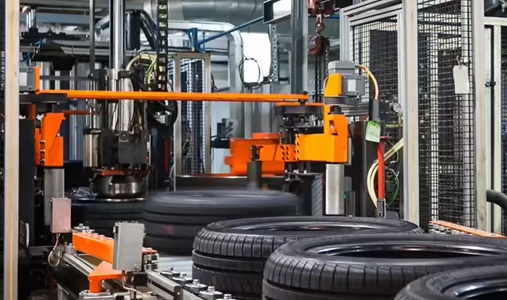The tyre industry in India in 2025 stands as a shining example of industrial progress, resilience, and technological evolution. As one of the largest automotive component sectors in the country, it plays a critical role in supporting India’s transportation, logistics, and manufacturing ecosystems. With rapid advancements in electric mobility, infrastructure expansion, and global trade, the Indian tyre industry has transitioned from a domestic-focused market to a globally competitive manufacturing powerhouse.

Overview: A Robust and Expanding Market
By 2025, the Indian tyre industry has grown into a ₹85,000–90,000 crore (USD 10–11 billion) market, reflecting steady expansion across both domestic and export segments. The industry accounts for nearly 3% of India’s manufacturing GDP and employs over 1.5 million people, directly and indirectly.
India now ranks among the top five tyre manufacturers globally, supported by strong domestic demand from the automotive industry and a growing international footprint. Tyres cater to diverse segments including passenger vehicles, commercial vehicles, two-wheelers, tractors, and off-the-road (OTR) vehicles.
The sector’s success is closely linked to India’s automobile growth, infrastructure development, and replacement market, which continues to account for over 60% of total tyre demand in 2025.
Industry Structure and Key Players
The Indian tyre industry is highly organized, with a few large companies dominating production and innovation. The top players include MRF Ltd., Apollo Tyres, JK Tyre & Industries, CEAT Ltd., Balkrishna Industries (BKT), and TVS Srichakra. These firms collectively command over 80% of the market share.
Each segment of the industry has unique growth drivers:
- Passenger Car and SUV Tyres: Demand is driven by rising vehicle ownership and premium tyre preferences.
- Commercial Vehicle Tyres: Fuel-efficient radial tyres are gaining traction due to logistics and e-commerce expansion.
- Two-Wheeler Tyres: Remain a high-volume category, especially in rural India.
- Agricultural and OTR Tyres: Supported by mechanization and global exports.
Companies are investing in smart tyres, radialisation, and sustainability to remain competitive in both domestic and global markets.
Policy and Government Support
Government policies have been instrumental in boosting the tyre industry’s competitiveness and manufacturing capability:
- Atmanirbhar Bharat (Self-Reliant India): Promotes domestic production of tyres and raw materials.
- Production-Linked Incentive (PLI) Scheme: Encourages investment in large-scale tyre manufacturing and related components.
- National Automotive Mission Plan 2026: Supports R&D for high-performance and eco-friendly tyres.
- Ban on Waste Tyre Imports: Protects domestic manufacturers and promotes recycling.
- Infrastructure and Road Development Programs: The expansion of highways, logistics parks, and rural roads under the PM Gati Shakti initiative has significantly increased demand for commercial vehicle tyres.
These supportive frameworks have enabled the industry to scale up production, modernize plants, and strengthen export competitiveness.
Technology and Innovation: The Road Ahead
The tyre industry in 2025 is undergoing a significant technological transformation. Manufacturers are prioritizing R&D, automation, and digitalization to enhance performance and sustainability.
- Smart Tyres: Integration of sensors to monitor air pressure, temperature, and tread wear is improving vehicle safety and efficiency.
- Radialisation: Over 95% of passenger car tyres and 75% of truck/bus tyres are now radial, ensuring better fuel efficiency and durability.
- Sustainable Materials: Increased use of silica, bio-based rubber, and recycled carbon black is reducing environmental impact.
- Electric Vehicle (EV) Tyres: With the rise of electric mobility, tyres are being redesigned to handle higher torque, instant acceleration, and noise reduction requirements.
- Automation and Robotics: Advanced manufacturing processes and AI-driven quality control are improving productivity and consistency.
These innovations are helping Indian manufacturers align with global standards and appeal to environmentally conscious consumers.
Export Growth and Global Footprint
The export segment of the tyre industry has witnessed remarkable growth in recent years. In FY 2024–25, tyre exports from India are estimated to have crossed USD 3 billion, up from USD 2.2 billion in 2021–22.
Indian tyres are now being shipped to over 150 countries, with strong demand from Europe, Africa, Latin America, and the Middle East. Manufacturers like Apollo Tyres and BKT have established global manufacturing bases and R&D centers to cater to international markets.
The quality, cost competitiveness, and reliability of Indian tyres have made them highly attractive alternatives to Chinese and Southeast Asian products.
Raw Materials and Supply Chain Dynamics
Rubber — both natural and synthetic — remains the most crucial input for tyre manufacturing. India, being the third-largest producer of natural rubber, has a significant advantage. However, fluctuations in global rubber prices and dependency on imported synthetic rubber continue to influence cost structures.
Manufacturers are increasingly focusing on domestic sourcing, rubber plantations in the Northeast, and sustainable procurement practices to stabilize supply and minimize environmental impact.
The logistics network has also improved significantly, with integrated supply chains and automated warehouses enhancing distribution efficiency across the country.
Challenges and Industry Headwinds
Despite its growth trajectory, the tyre industry faces several challenges:
- High Input Costs: Volatility in raw material prices, especially rubber and crude oil derivatives, affects margins.
- Import Competition: Low-cost imports from China and Southeast Asia continue to pressure local players.
- Environmental Compliance: Disposal and recycling of used tyres remain regulatory priorities.
- Technology Gap in MSME Segment: Smaller manufacturers struggle to adopt modern processes and quality standards.
Addressing these issues through policy consistency, R&D investment, and industry collaboration will be key to sustaining momentum.
Future Outlook: Rolling Toward a Sustainable Future
By 2025, the Indian tyre industry is shifting gears toward sustainability, digital transformation, and global leadership. With the EV revolution and green manufacturing practices taking center stage, tyre makers are aligning their strategies with global automotive trends.
The next phase of growth will be driven by:
- Expanding exports to new regions.
- Developing advanced tyres for EVs and autonomous vehicles.
- Scaling up recycling and circular economy initiatives.
- Deepening domestic manufacturing of synthetic rubber and raw materials.
Analysts project that by 2030, India’s tyre industry could reach a market size of ₹1.3 lakh crore (USD 15–16 billion), firmly establishing India as a global tyre manufacturing hub.
Conclusion: India’s Tyre Industry on the Fast Lane
The tyre industry in India in 2025 reflects the country’s broader industrial evolution — from cost-driven production to technology-led excellence. Supported by strong domestic demand, robust policy backing, and rising export competitiveness, Indian tyre manufacturers are rolling confidently toward global leadership.
With innovation, sustainability, and quality as its guiding wheels, the industry is not just driving vehicles — it’s driving India’s journey toward industrial self-reliance and sustainable mobility.

